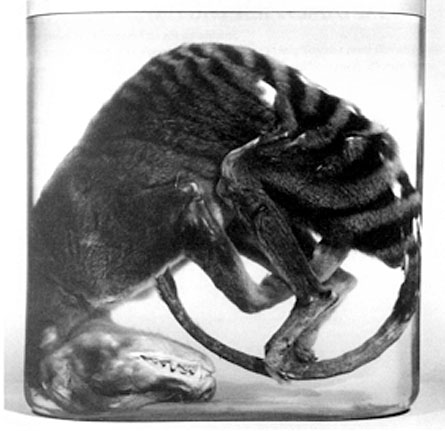- More than 2 years ago
Tasmanian tigers, also known as thylacines, had dangerously low genetic diversity decades before disease and human hunting drove them extinct, an analysis of the first complete mitochondrial genomes from the extinct marsupials reveals.

An international group of scientists used powerful new technology to decode mitochondrial and some nuclear DNA from two thylacine museum specimens. The researchers report their findings online January 13 in Genome Research.
“It’s looking like the thylacines were sort of on their last legs,” says Webb Miller, a genomicist at Pennsylvania State University in University Park and lead author of the new study.
Thylacines were carnivorous marsupials that resembled dogs with tiger stripes. The animals were often called Tasmanian tigers or Tasmanian wolves, even though thylacines were not related to any type of feline or canine. Thylacines once inhabited the Australian mainland but disappeared from there about 2,000 years ago. It was thought that the arrival of dingoes 1,500 years earlier contributed to the tigers’ disappearance from the mainland.
After their disappearance from mainland Australia, thylacines were confined to the island of Tasmania, but disappeared after Europeans settled on the island and issued a bounty on the animals.” The last captive thylacine died in 1936 and there have been no confirmed sightings of the animals in the wild since then.
Efforts to isolate thylacine DNA have also been largely unsuccessful, with only two putative thylacine sequences appearing in GenBank, a repository of DNA sequences used by scientists around the world. Researchers in the new study used so-called next-generation sequencing to decode DNA from a thylacine that died in 1893 and was preserved in ethanol. The researchers also extracted DNA from hair from the dried pelt of a thylacine that died in 1905 at the National Zoo in Washington. In both cases, the DNA was heavily contaminated with DNA from humans and microbes, but the researchers were able to piece together long stretches of thylacine DNA.
The researchers delineated all the letters that make up the circle-shaped genome of mitochondria. Mitochondria are energy-generating organelles within eukaryotic cells. The organelles likely evolved from bacteria and still have their own genomes, separate from the genetic instruction book in the cell’s nucleus. Scientists often use mitochondrial DNA to determine relationships between species. The researchers compared the thylacine sequence with DNA from existing numbats to establish the Tasmanian tiger’s place on the tree of life. The analysis revealed that thylacines were likely the base of the tree from which other insect-eating and carnivorous marsupials evolved.
Only five letters of the 15,492 that make up the thylacine mitochondrial genome differed between the two specimens. So few differences between two individuals of the same species could indicate extremely low genetic diversity, which could spell doom for the thylacines, Miller says.
A bounty placed on the animals was thought to be the cause of the thylacine’s extinction, but low levels of genetic diversity could also have contributed to the disappearance of the Tasmanian tiger, says Miller. A distemper-like disease swept through wild and zoo thylacine populations from 1900 to 1910. A lack of genetic diversity could have left the animals susceptible to the disease.
One of the thylacine’s closest living relatives is the Tasmanian devil. Tasmanian devils also have very low genetic diversity both in mitochondrial DNA and in genes of the immune system, says Jeremy Austin, an evolutionary biologist at the Australian Centre for Ancient DNA at the University of Adelaide. Devil populations have been hit hard by Devil Facial Tumor Disease, a cancer that spreads through bites like a contagious disease. The devils’ immune systems do not fight off the cancer.
“Certainly, if thylacines had an immune system that was as depaupered as Tasmanian devils’ it’s possible that a new disease could have contributed to their extinction,” Austin says.
But low genetic diversity doesn’t always spell extinction, Miller says. Cheetahs also have low genetic diversity and are still surviving, he points out.
“How do you look at a genome and decide whether a species is going extinct? We’re not sure,” Miller says.
Although the relationship between diversity and extinction is still a matter of debate, information about genetic diversity could be useful for preserving endangered species, says Oliver Ryder, a geneticist involved in conservation research at the San Diego Zoo.
“From the point of view of conservation biology, there are danger flags going up when you see low levels of genetic diversity,” Ryder says.
Studies of mitochondrial diversity in endangered animals could help identify species killed in the illegal bush meat trade, aid in breeding programs and show the geographic distribution of gene diversity in a species to help determine where boundaries of reserves should be established, he says.






